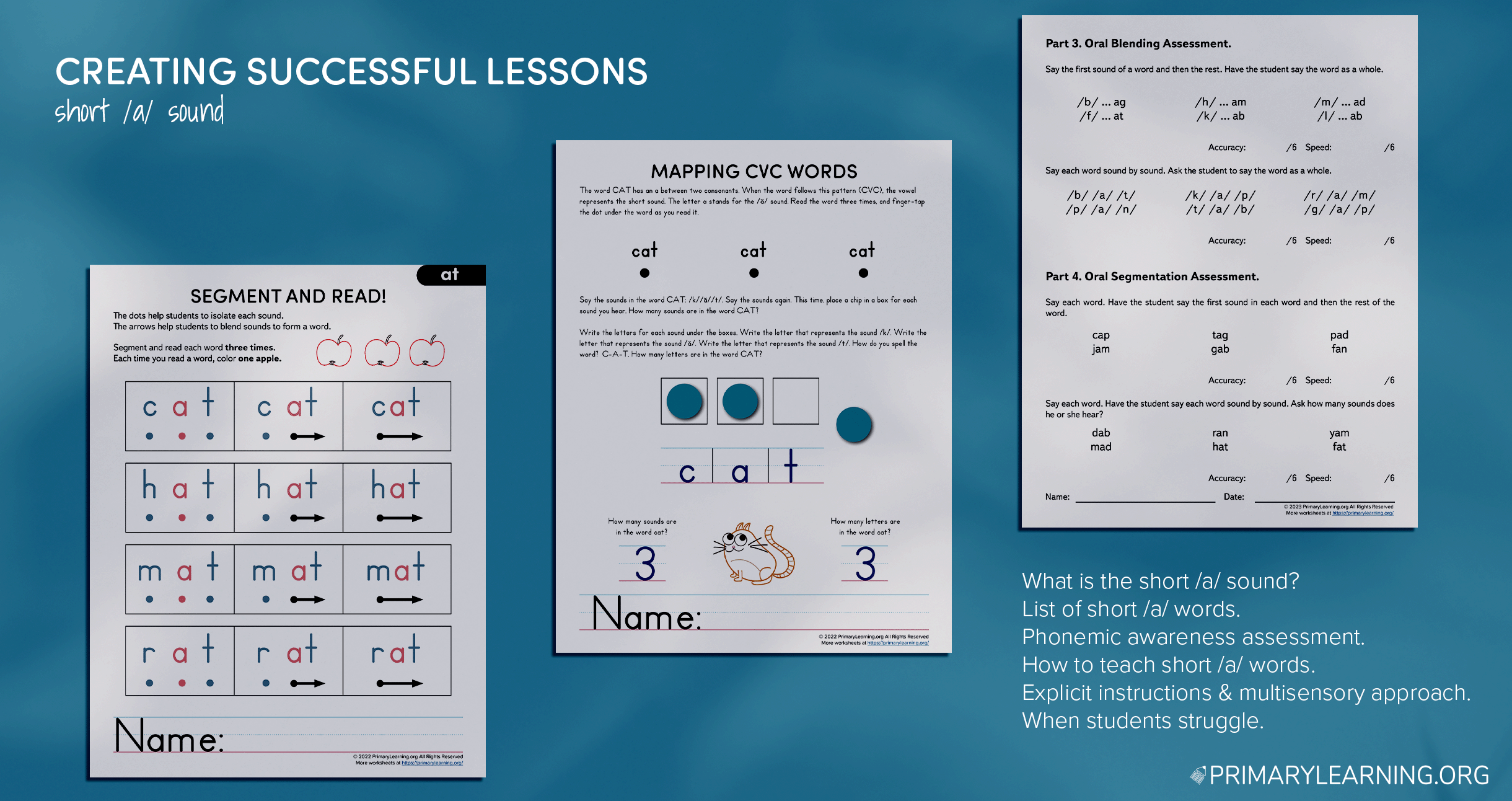

Posted by: Alesia Netuk
Updated: October 10th, 2023
Sounding it Out: A Comprehensive Guide to the Short A Sound Words
Sounding it Out: A Comprehensive Guide to the Short A Sound Words
Beginning readers often start learning to read with short vowels. Fewer spelling variations, common spelling patterns, and high frequency make them an ideal starting point for beginning readers. Some short vowels have multiple spelling patterns, while others only have one, such as the Short A sound.
What is the Short A Sound?
The short A vowel sound is an open middle vowel sound. To make the /ă/ sound, the front part of the tongue is low in the mouth. The lips are unrounded1.
A curved symbol above the vowel represents a short vowel: /ă/.
The most common spelling of the /ă/ sound is as in cat.
Words that start with a short /ă/ sound: apple, alligator, astronaut, axe, acrobat, apricot, add, ask, adult, alley.
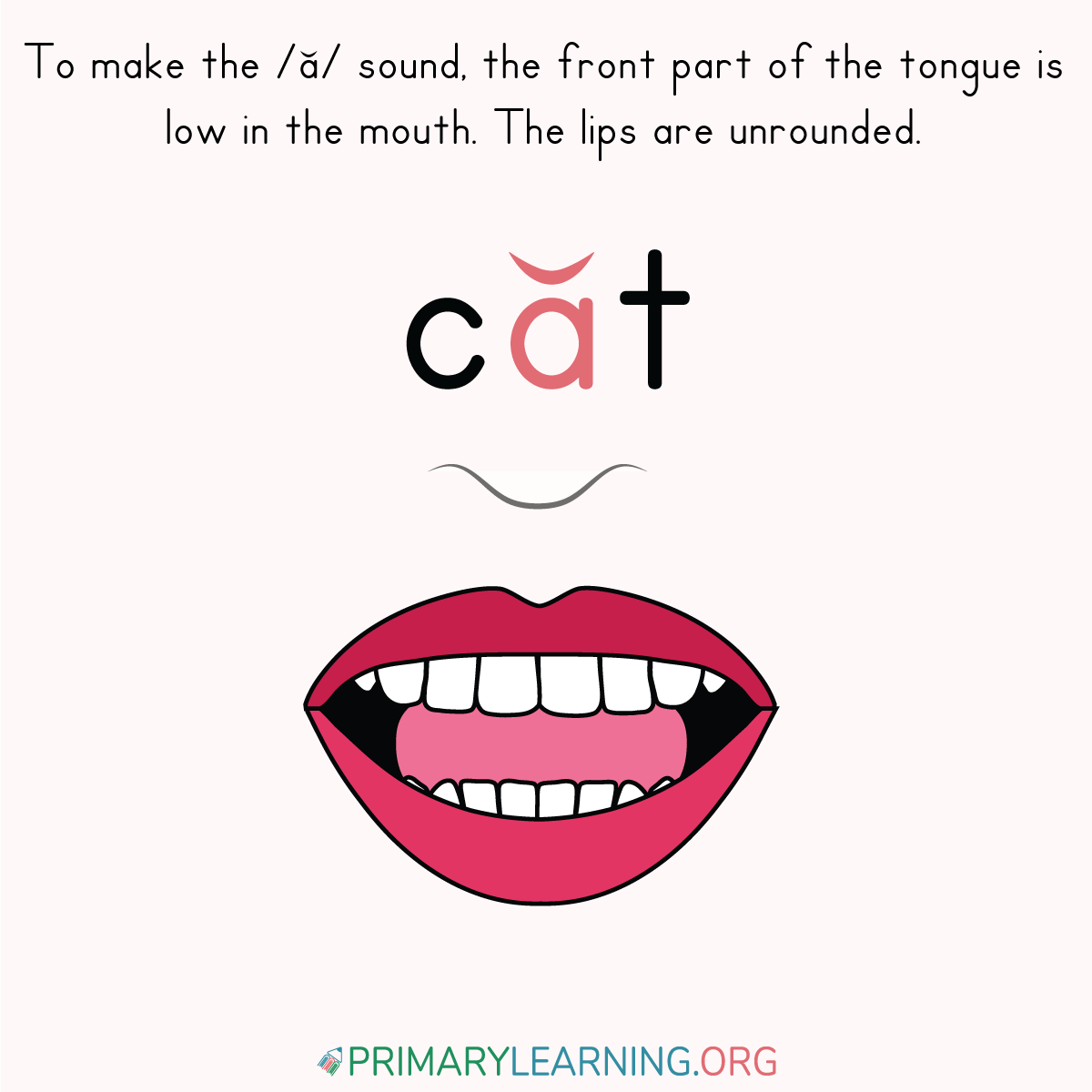
What is a spelling pattern?
A spelling pattern is a group of letters that represents a sound. Around half of English words are spelled according to their corresponding sound patterns, meaning that their letters reflect their pronunciation.
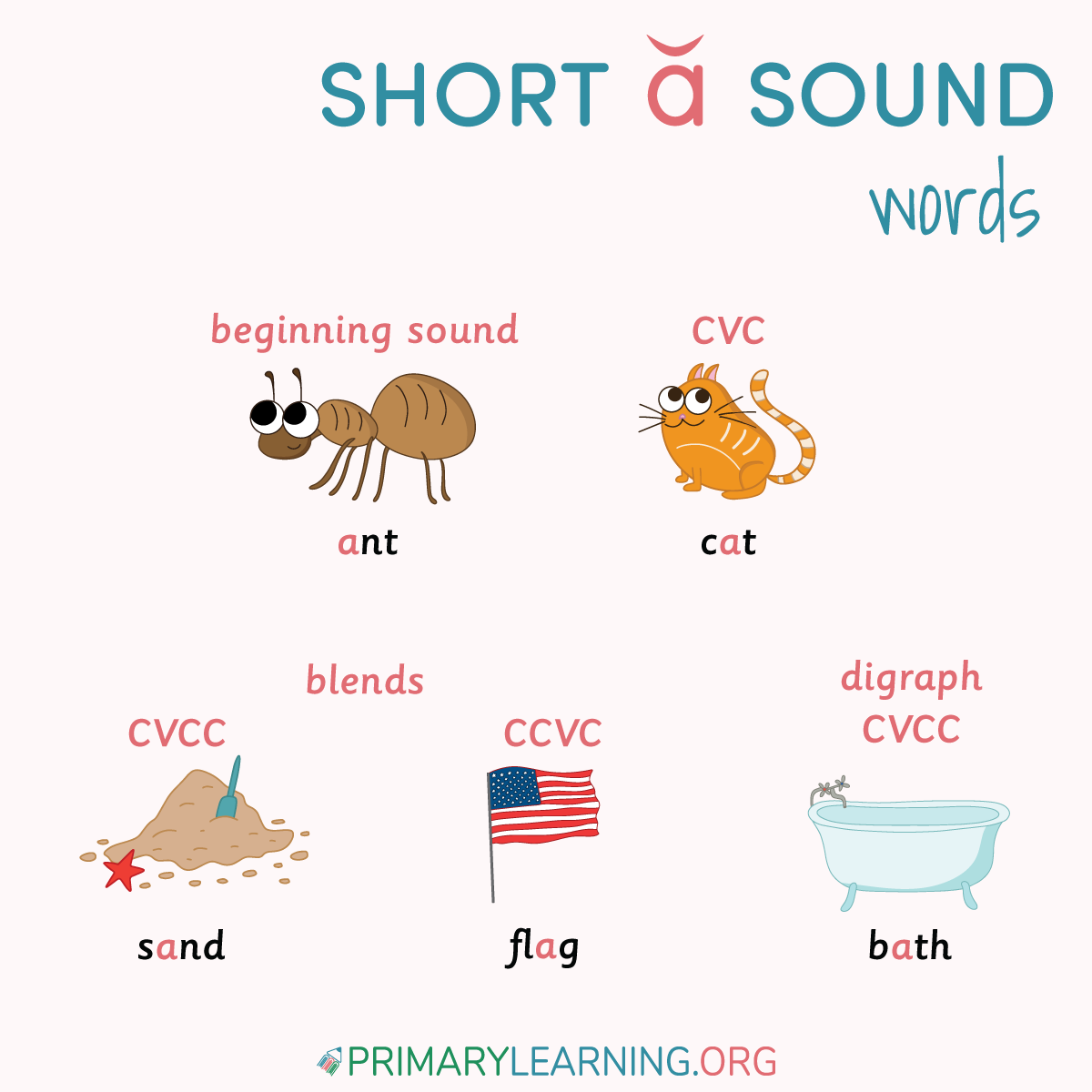
What are CVC Words?
A CVC word is a closed syllable three-phoneme (sound) word that follows the pattern of consonant-vowel-consonant. When the word follows this pattern, the vowel represents its short sound. The most common CVC spelling patterns with a short /a/ sound are AB, AD, AG, AM, AN, AP, AT, and AX.
Short A Sound – Blends and Digraphs
A CVCC and CCVC words are closed syllable four-phoneme (sound) words that follow specific letter sequences of consonant and vowel sounds. When the word follows these patterns, the vowel represents its short sound. The most common CVCC spelling patterns with a short /a/ sound are ACK, ACT, AFT, AMP, AND, ANG, ANK, ANT, ASK, ASM, ASP, and AST.
Other spelling patterns with a short /a/ sound are ANCE, ANCH, ASH, ACTH, and ATH.
List of Short A Words (CVC Words)
List of Short A Words (Blends and Digraphs)
| ACK | ACT | AFT | AMP | ANCE | ANCH | AND | ANG | ANK | ANT | ASH | ASK | ASP | AST | ATCH | ATH |
| back | fact | daft | camp | dance | ranch | band | bang | bank | pant | bash | ask | gasp | cast | batch | bath |
| hack | pact | raft | damp | lance | blanch | hand | fang | Hank | rant | cash | cask | hasp | fast | catch | math |
| Jack | tact | waft | lamp | chance | branch | land | gang | lank | chant | dash | mask | rasp | last | hatch | path |
| knack | tract | craft | ramp | France | sand | hang | rank | grant | gash | task | clasp | mast | latch | wrath | |
| lack | draft | vamp | glance | bland | pang | sank | plant | hash | flask | grasp | past | match | |||
| Mack | graft | champ | prance | brand | rang | tank | scant | lash | vast | patch | |||||
| pack | shaft | clamp | stance | gland | sang | yank | slant | mash | blast | scratch | |||||
| quack | cramp | trance | stand | clang | blank | rash | snatch | ||||||||
| rack | scamp | strand | slang | clank | sash | thatch | |||||||||
| sack | stamp | sprang | crank | brash | |||||||||||
| tack | tramp | twang | drank | clash | |||||||||||
| black | flank | flash | |||||||||||||
| clack | Frank | slash | |||||||||||||
| crack | plank | smash | |||||||||||||
| shack | prank | stash | |||||||||||||
| slack | spank | thrash | |||||||||||||
| smack | thank | trash | |||||||||||||
| snack | |||||||||||||||
| stack | |||||||||||||||
| track | |||||||||||||||
| whack |
Other uncommon spellings1:
a_e – like in a word have;
ai – like in a word plaid;
al – like in a word half;
au – like in a word laugh;
aa – like in a word baa;
ach – like in a word drachm;
ag – like in a word diaphragm;
ui – like in a word guimpe;
ah – like in a word dahlia;
i – like in a word meringue
ua – like in a word guarantee.
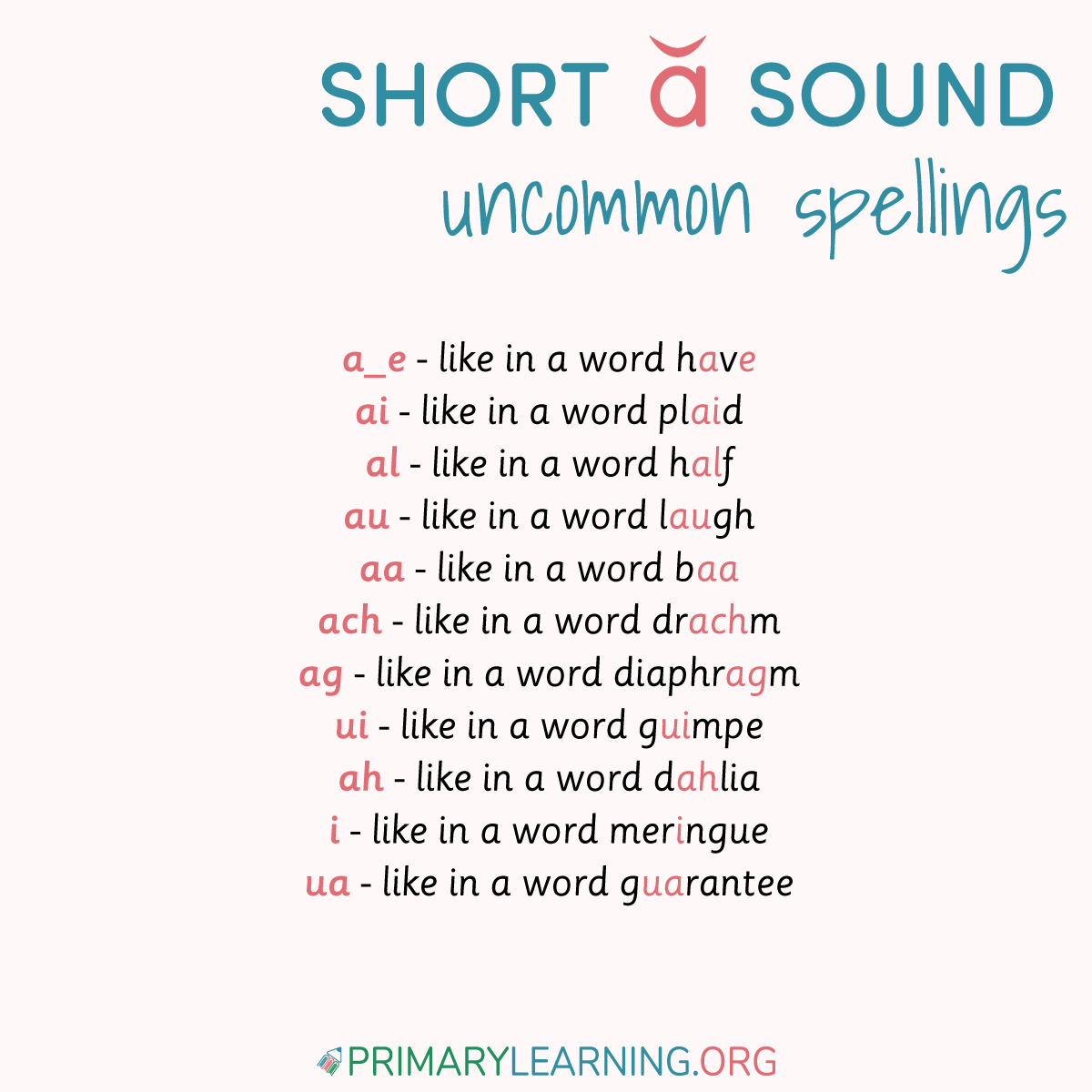
How to Teach Short A Words
Teach one spelling pattern at a time. Once it is mastered, you can add another CVC word family with a short A sound. It’s much easier to learn how to read short A words within one family than to learn how to spell different words.
In What Order Should I teach Short A Word Families?
There is no particular order to choose from. We recommend starting with AT word family. Once students can identify the letters and their sounds, they change the first letter of the word and create a new word. We recommend separating confused letters and word patterns to avoid confusion. For example, do not teach AD-AB, AB-AP, AD-AG, AD-AP, and AM-AN word families at the same time.
We recommend the following order: AT, AB, AP, AD, AM, AN.
Phonemic Awareness Assessment

The first step in creating successful lessons is determining your students’ phonics knowledge. A good phonics assessment will help you pinpoint where the decoding instruction needs to begin. Can students find a rhyming word? Can students blend and segment words with accuracy and speed? Planning activities for the phonics lessons would be more efficient when they are based on students’ needs and focus on improving and reinforcing skills.
The short A sound assessment consists of six parts: rhyming assessment, phoneme categorization assessment, oral blending assessment, oral segmentation assessment, phoneme manipulation assessment, and reading non-sense words. Assess one student at a time and note areas where the student needs more work. Provide instructional and independent materials for each child based on the results of the assessment.
Blending and Segmenting Short A Words
Blending and segmenting are fundamental skills to teach young readers. The ability to blend sounds together and break sounds apart supports both reading and writing development. Developing phonemic awareness is especially important for students identified as being at risk for reading difficulty3.
Phonemic Activities – Oral Blending and Oral Segmentation
Oral Blending. Picture cards can be added to these activities to provide an additional reference for children.
Onset/rime. Listen to these word parts: /k/ … at. Say the word as a whole. What is the word? (cat)
Phoneme by phoneme. Listen to these word parts: /k/ /a/ /t/. Say the word as a whole. What is the word? (cat)
Oral Segmentation. Onset/rime. Listen to this word: cat. Say the first sound in the word and then the rest of the word. /k/ … at
Phoneme by phoneme. Listen to this word: cat. Say the word sound by sound. /k/ /a/ /t/
Phonics Activities – Blending and Segmentation
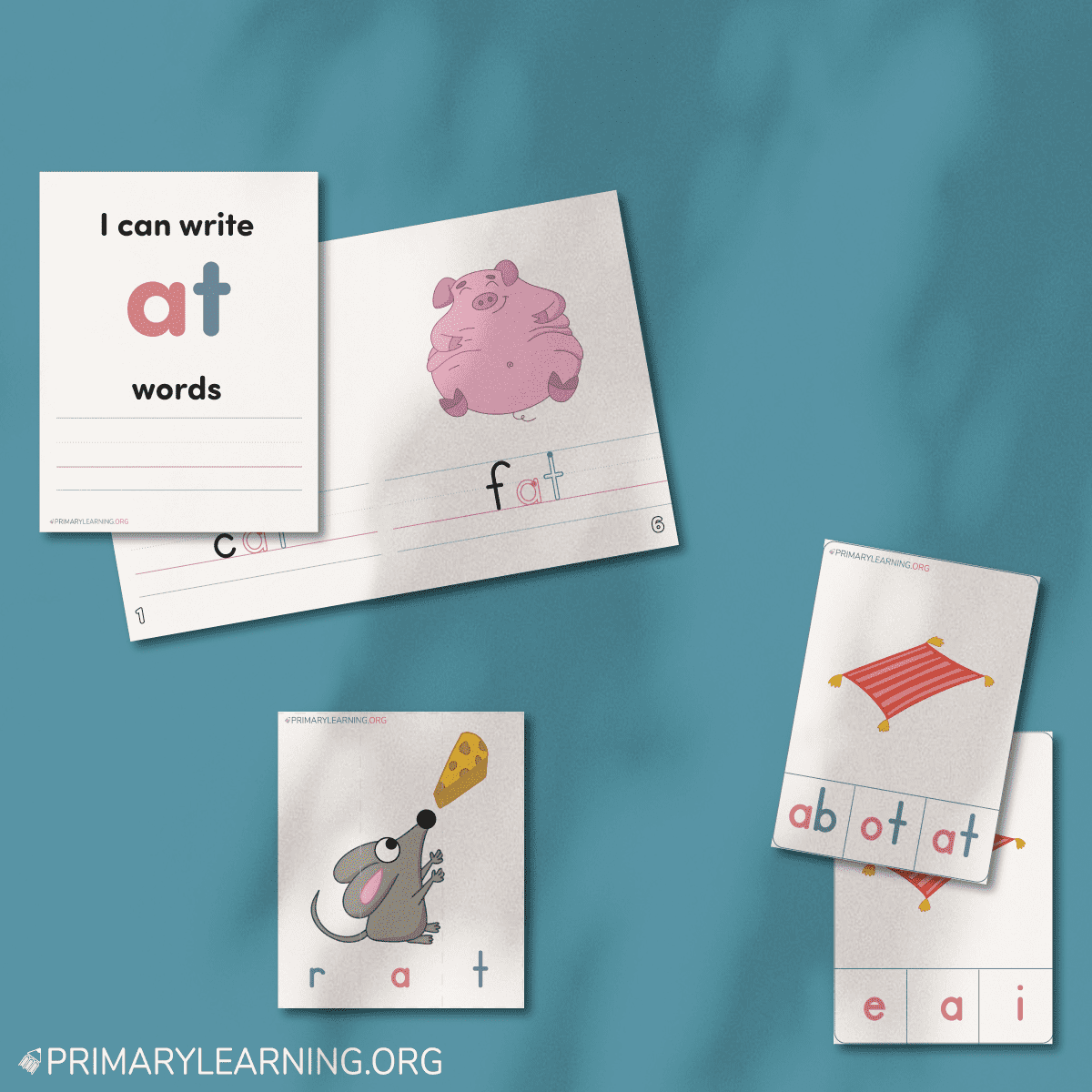
Puzzles would be a great addition to your literacy center. Students compose a puzzle letter by letter, say individual sounds, and then blend sounds to read the word.
Short A mini-books are created with just a single sheet of paper. Students read the word, identify the rime, and trace it. Students explore words from different word families, learning how the word changes when the initial letter has changed. With these mini-books, phoneme manipulation activities can be easily added. Going from one word to another, ask the student what initial letter/sound has changed.
Short A clip cards are another powerful tool for literacy centers. students learn to identify the middle sound or the rime (depending on which cards they choose).
We offer a lot of printable worksheets to practice blending and segmenting for each word family. Create a mix of independent or guided practice for each student in the classroom. Below are samples for the AT word family. Other word families can be found here: AT word family printables, AB word family printables, AP word family printables, AD word family printables, AM word family printables, and AN word family printables.
Building and Sorting Short A Words
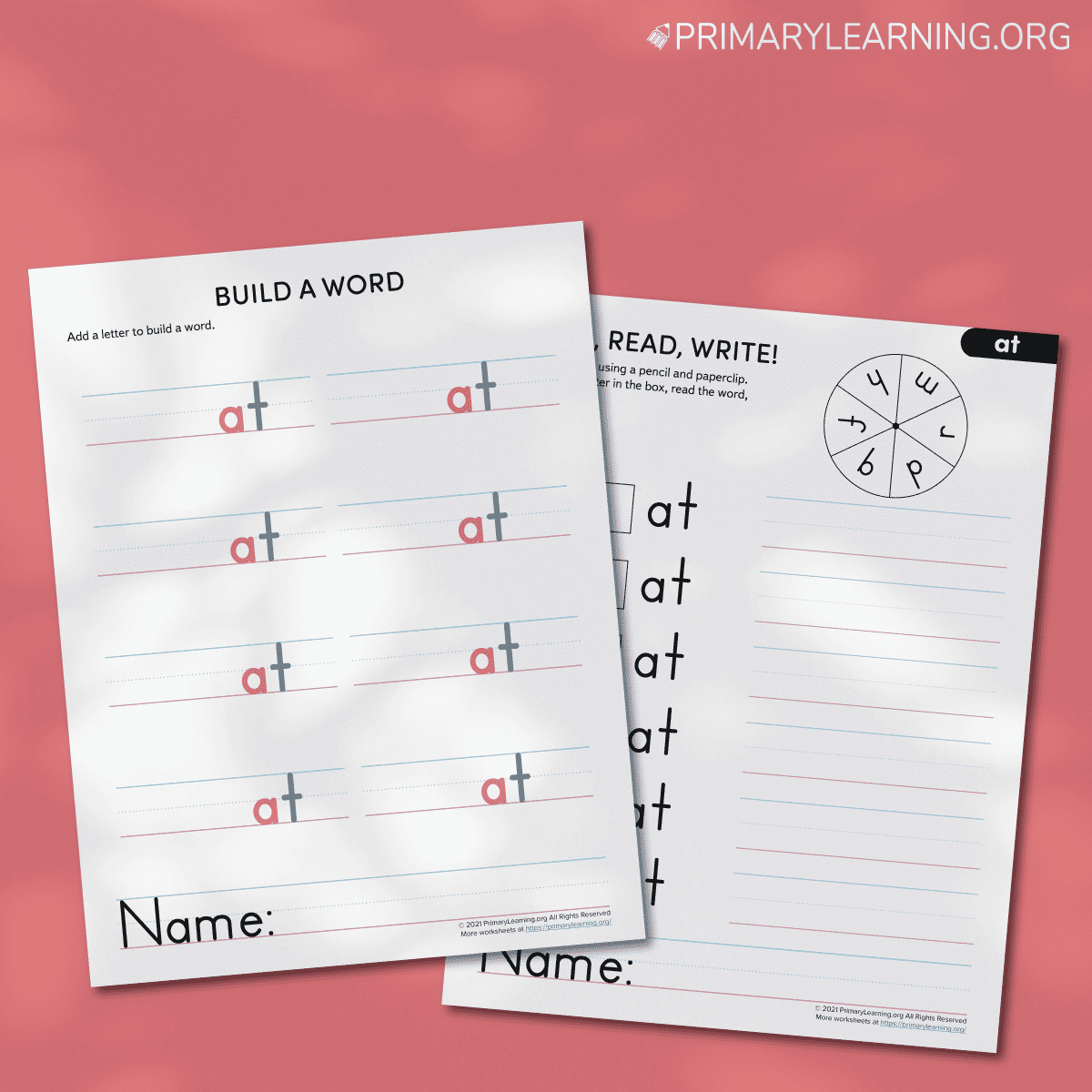
Word building is an excellent exercise to increase a student’s word awareness. In this activity, students build words that vary by only one sound from the previous word. Ask students to make a word cat, then ask them to change the letter c to the letter r and read a new word.
Another way of word-building activity can be when students are asked to change the word cat to the word rat. That will require more thinking and comparison skills to analyze both words.
Short A word scrambles are another way to recall the word spelling from a student’s memory. Ask the student to work on the worksheet using the wallowing steps:
- First, start by looking at the vowel – A. Once the vowel is identified, write it in the middle.
- Next, start looking for the chunk (ending rime) – AT. Once the student spotted the letter T, write it. (students can cross out letters they found and wrote).
- Now, a student has a skeleton of a word, and they can finish it. Ask him what the initial letter in this word is. Once written, ask the student to read the word. Then, move to the next word.

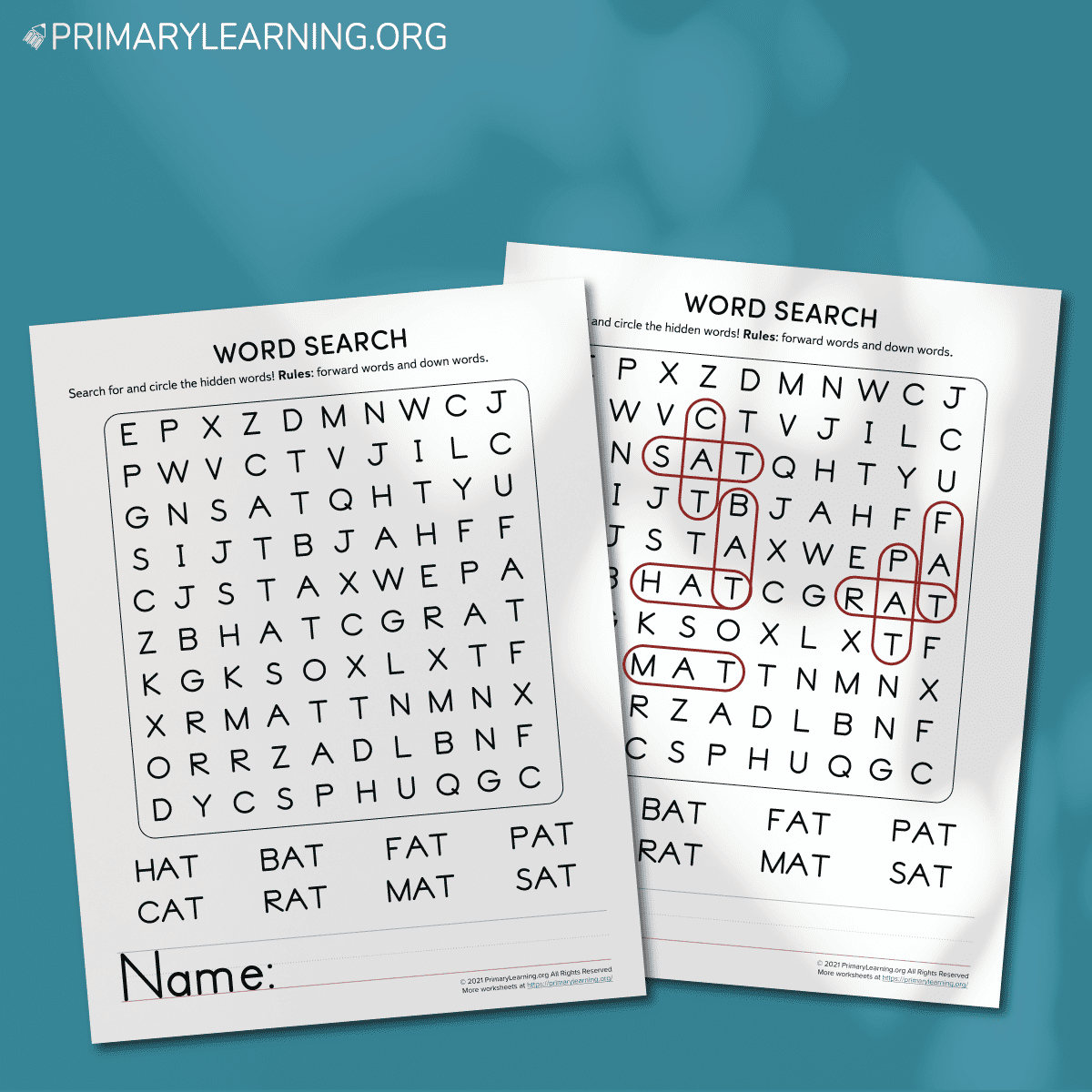
Short A word searches are great activities and help students develop spelling, problem-solving, and analytical skills. Here are some tips on how to play and find words:
- Scan with a finger each row from left to right. Then, scan each column from top to bottom. Look for the vowel – A.
- Once spotted, start exploring the adjusted letter and search for the chunk – AT.
- Once the chunk is spotted, look for surrounding letters and think about what word it can be.
Orthographic Mapping
Orthographic mapping requires both phonemic awareness and phonics skills. They both work on developing automatic word recognition and identifying a word “on sight”. Some students develop those skills faster, while others need more time, explicit instructions, guidance, and repetition.
With orthographic mapping, students take a whole word, break it into sounds and connect it to the correct letter (or letter combinations). Students pay attention to the exact sequence of the letters and how they are connected to the sounds. This process helps students store the word in long-term memory and read it “by sight.” Try mapping the word cat, and provide explicit instruction and feedback for students.
Writing, Spelling & Dictation
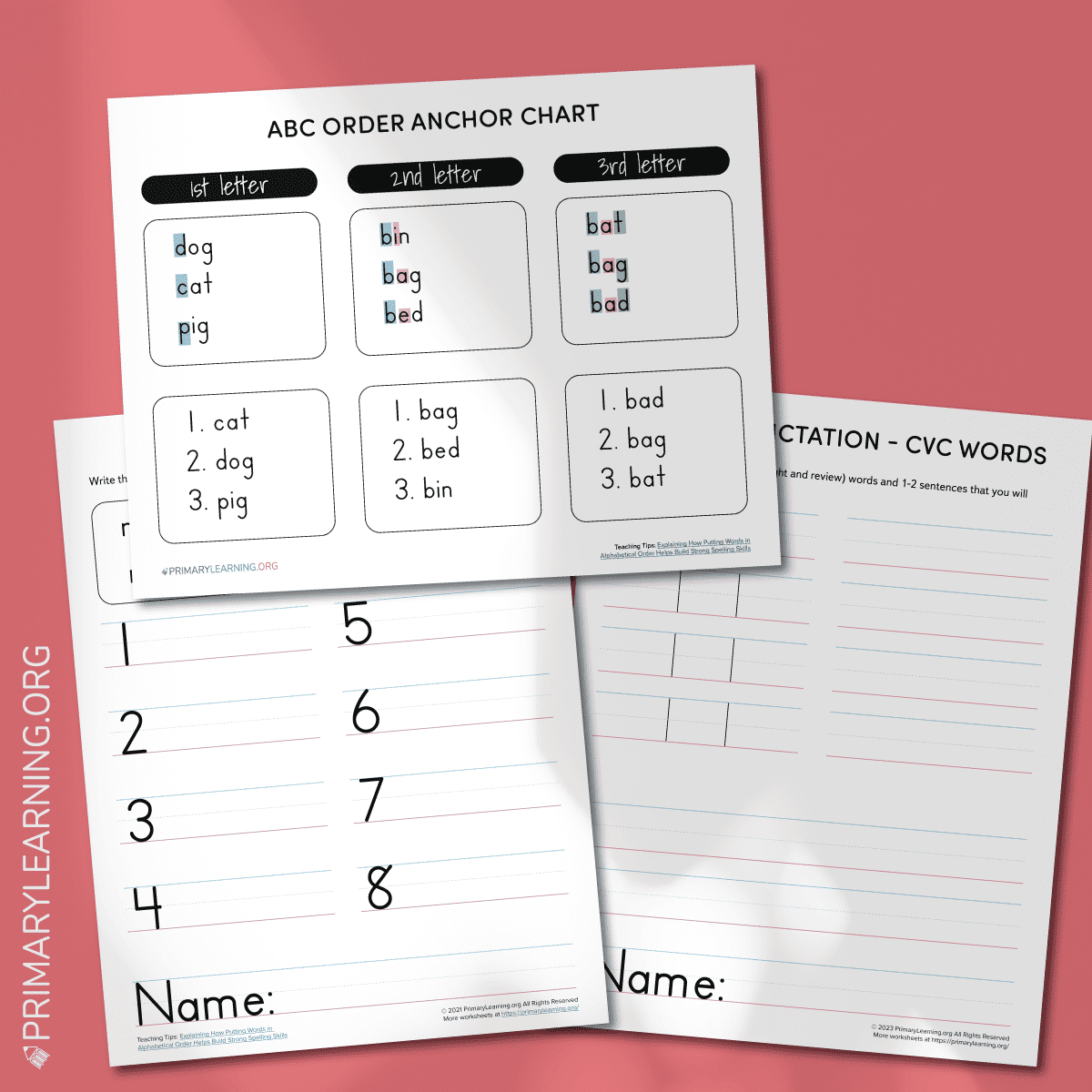
Add dictation and writing practice. Dictation helps young learners develop short-term memory. It is an engaging way to accelerate their spelling skills with guidance and feedback. Dictation can be an exceptional review exercise.
Prepare a list of 4 – 5 short A words and 1-2 sentences that you will dictate. Include recent short A words and review words to the list. First, students write graphemes for each phoneme they hear. Then, write the whole word. When students finish, write the correct spelling on the board so everyone can see it. Let students check their word and correct it if needed. Dictate a sentence, and make sure the sentence is short and students are not exhausted.
Sorting words in alphabetical order improve spelling skills and word manipulation. If a student is struggling to order short A words correctly, provide him or her additional support. This poster shows how to order and write words in ABC order.
These short A worksheets are great for building strong spelling skills:
Making AT Word Family Sentences
Kids learn to write sentences with AT word family words using the word bank. Encourage kids to share their writings with classmates.
Making AT Word Family Sentences
Read and Spell AB Family Words
With this printable activity, kindergarteners learn to read and spell AB family words. Great addition to your literacy center and AB word family word work.
Read and Spell AB Family Words
AB Family Words – Kindergarten
This AB family words activity is perfect for independent practice. Kids stretch out the words and write them in boxes. Words: stab, cab, gab, tab, dab, grab, crab, lab.
AB Family Words – Kindergarten
Write AB Family Words
With this worksheet, kids develop phoneme categorization and segmentation skills when reading and writing AB family words: dab, lab, cab, tab.
Write AB Family Words
Reading Short A Words and Building Vocabulary
Understanding the short A spelling patterns is more than just reading a single word. After students master reading words with accuracy and speed, move to the short sentence and passages. Use decodable text featuring the short A sound and check comprehension.
AB Word Family Reading Fluency
AB word family reading fluency activity helps kids understand word patterns and see “chunks” in words. Words: grab, lab, cab, tab, dab, crab, stab, gab.
AB Word Family Reading Fluency
AT Word Family Reading Comprehension
AT word family reading comprehension simple story for kindergarten kids! This worksheet has 6 activities, including reading passage and focuses on words ending -at.
AT Word Family Reading Comprehension
A-MAZE-ING AB Family Words Sentences
This download includes A-MAZE-ING AB Family Words Sentences. Kids will be super excited to solve the maze and practice reading AB words: cab, dab, lab, tab.
A-MAZE-ING AB Family Words Sentences
Cloze the Gap! – AB Family Words
This worksheet focuses on independent reading and comprehension (context clues). Kids read AB family words and build strong vocabulary skills: dab, lab, cab and tab.
Cloze the Gap! – AB Family Words
Explicit Instructions & Multisensory Approach
Explicit Instructions and Orthographic Mapping when Teaching Short A Words
Today, you’re going to learn the word CAT. Say the word. (cat) The word CAT has an A between two consonants. When the word follows this pattern, the vowel represents the short sound /a/ Say the short A sound. (/a/) In the word cat, the letter A stands for the /a/ sound.
READ IT.
Read the word three times, and finger-tap the dot under the word as you read it.
SOUND OUT & MAP IT
In this section, students learn how to segment word phoneme by phoneme and count how many sounds the word has.
Listen to this word: cat. Say the sounds in the word CAT: /k//a//t/. Say the sounds again. (/k/ /a/ /t/) This time, place a chip in a box for each sound you hear. How many sounds are in the word CAT? (3)
WRITE IT
In this section, students write the letters for each sound, count how many letters the word has, and build spelling skills.
Now, write the letters for each sound under the boxes. What letter represents the sound /k/? (c) Writhe the letter C. What letter represents the sound /a/? (a) Write the letter A. What letter represents the sound /t/? (t) Write the letter T. How do you spell the word? C-A-T. How many letters are in the word CAT? (3)
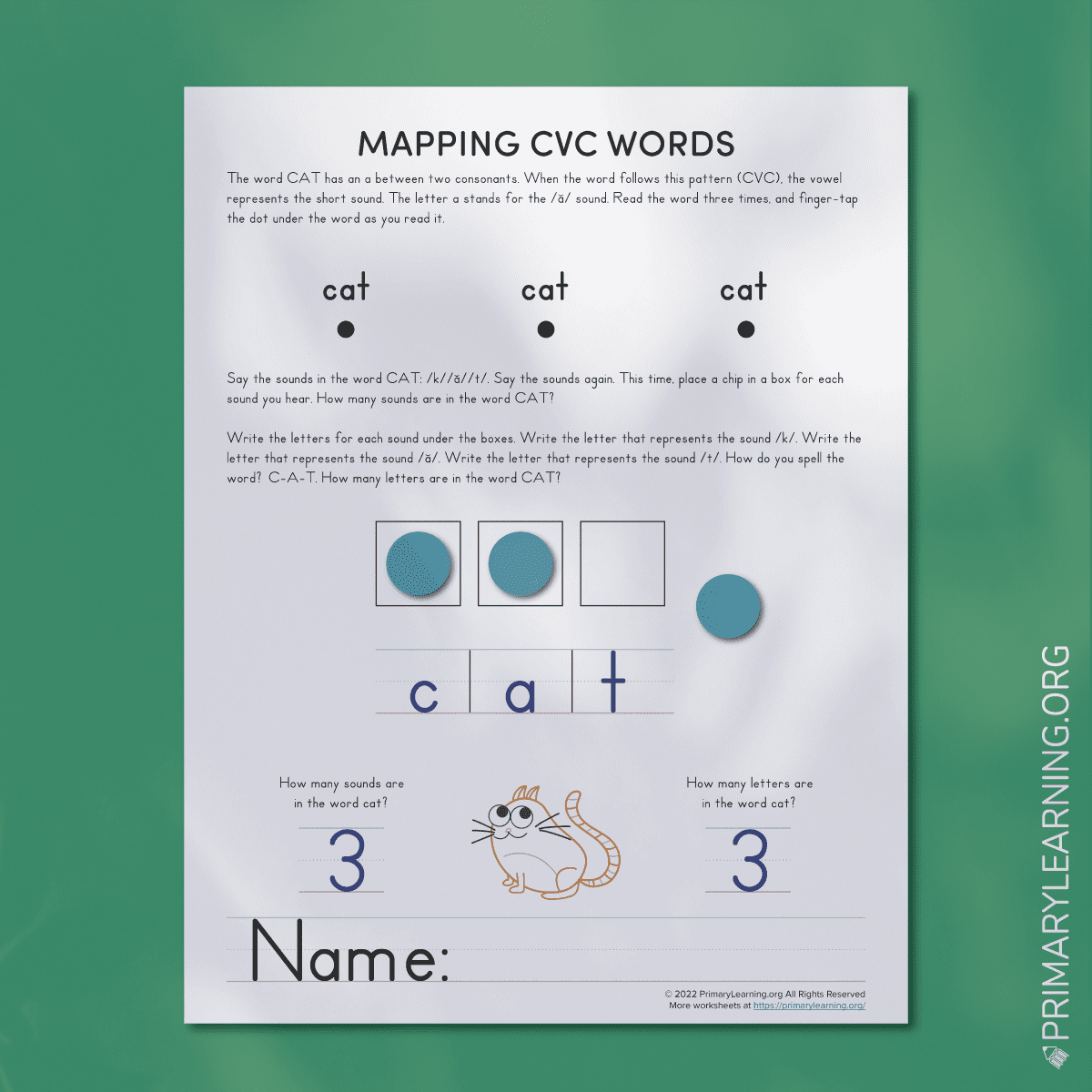
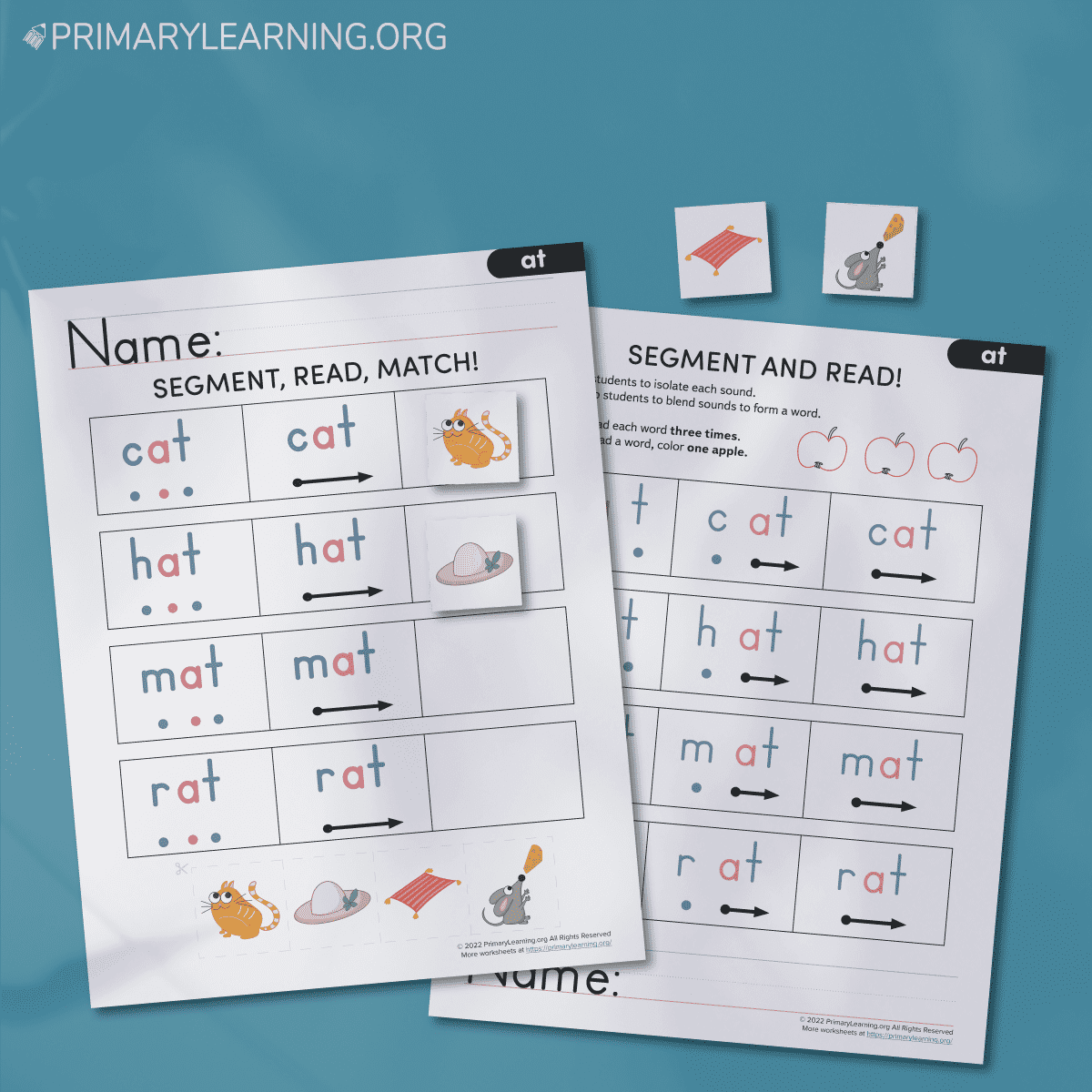
Explicit Instructions and Segmenting Words when Teaching Short A Words
Today, you’re going to learn how to read words ending AT.
Worksheet1. Segmenting words by onset/rhyme and phoneme by phoneme. Learning to count phonemes in spoken words.
Look at the first word. Finger-tap each letter to sound it out. (/k/ /a/ /t/) How many sounds do you hear? (3) Great! Now read the first sound and then the rest of the word. Slide your finger across the arrow as you read it. (/k/ … at) Great! Now read the word and slide your finger across the word as you read. (cat)
Now let’s move to the next row. Look at the word. Finger-tap each letter to sound it out. (/h/ /a/ /t/) How many sounds do you hear? (3) Great! Now read the first sound and then the rest of the word. Slide your finger across the arrow as you read it. (/h/ … at) Great! Now read the word and slide your finger across the word as you read. (hat)
Continue with the words hat, mat, and rat.
Worksheet 2. Segmenting words phoneme by phoneme. Learning to count phonemes in spoken words.
Look at the first word. Finger-tap each letter to sound it out. (/k/ /a/ /t/) How many sounds do you hear? (3) Great! Now read the word and slide your finger across the word as you read. (cat) Find and glue the picture of a cat next to the word.
Continue with the words hat, mat, and rat.
When Students Struggle
The most common struggle with reading short /a/ sound words is weak letter-sound correspondence skills when students need help matching letters with the correct sounds. This can lead to difficulty memorizing words and storing them in long-term memory. Start with short /a/ sound clip cards and let struggling students identify the middle sound or the rime. Then, move forward with blending onset and rime to sound out short /a/ words.
Elkonin boxes are great phonics intervention tools to build phonological awareness skills by segmenting words into individual sounds. Orthographic mapping is another strategy to help struggling students. Through orthographic mapping, students use the oral part of their brain to map the sounds of words they already know to the letters in a word. Give students more practice and slowly move from one word to another.
Decoding activities are great for struggling students. Decoding is when students recognize that each letter makes a specific sound, then blend them to read the word. This reading process is also known as “sounding it out.”
The multisensory approach provides visual, auditory, and kinesthetic activities, enhancing the learning process and students’ memory.
LEARNING MATERIALS TO MEET EVERY CHILD’S NEEDS
Here, at PrimaryLearning.Org, we tend to deliver the best-differentiated learning materials to K-2 students. Our resources can be easily incorporated into multisensory lessons to meet every child’s needs, whether s/he is a visual, kinesthetic, or auditory learner.
References
-
- Phonics from A to Z by Wiley Blevins
- The Students’ Ability In Pronouncing Long And Short Vowels In English Vocabulary by IJEAL
- Why Phonological Awareness Is Important for Reading and Spelling by Reading Rockets